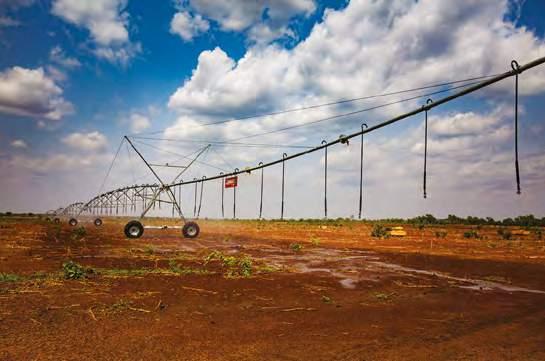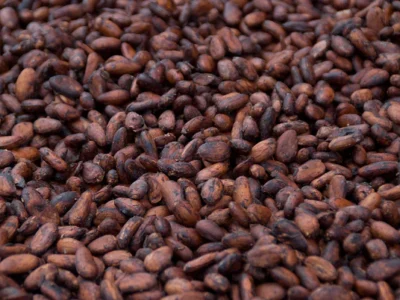The agricultural sector in Ghana is a major contributor to the economy, employing 33 per cent of the country’s active workforce. In 2021, it accounted for 21 per cent of the country’s gross domestic product. While it is currently dominated by subsistence farming, the government of Ghana has renewed its focus on the sector and is aiming to mechanise and boost production through a number of targeted interventions, in order to support an agroprocessing industry.
The agricultural land area covers approximately 13.6 million hectares, representing about 57 per cent of the country’s territory. Out of this, a total of 6.8 million hectares, representing about 50 per cent, is under cultivation, with 222,978 hectares under irrigation. The climatic conditions in the country, a mix of sufficient rain, sunshine and humid-
ity, are ideal for crop production.
The main cash crop is cocoa, which has been planted in Ghana since it was introduced to the country in 1879 by Tetteh Quarshie, a native who had
discovered it in Fernando Po in present day Equatorial Guinea. Ghana is currently the second highest producer of cocoa in the world behind Côte d’Ivoire, and in 2021, earned $2 billion from exports, about 60 per cent in the raw state. This represented about 19 per cent of the country’s total exports in that year.
Ghana also produces and exports timber products. In 2020, 25,890 cubic metres of timber billets were exported from the country, 4.7 per cent more
than were exported in the previous year. The increase in exports has also been accompanied by an improvement in the quality of timber products, which is reflected in the increase in export revenue.
Fish accounts for about 60 per cent of protein in Ghana and mainly comes from marine sources, although investments into aquaculture have resulted in a growth in the sector. In 2018, 76,620 metric tonnes of fish were sourced from aquaculture, an increase of 18 per cent on the previous year. Livestock farming in Ghana is focused on chickens, goats, sheep and cows. Chicken dominates the sub-sector, with 75,202 tonnes produced in 2021.
The government has undertaken a number of initiatives to boost productivity in the agricultural sector. In 2016, the Ghana Cocoa Board launched the Production Enhancement Program to rehabilitate infected cocoa farms in order to increase annual cocoa production to a minimum of 1 million tonnes. The One Village One Dam policy in the north of the country, and several irrigation projects in parts of the south, are intended to reduce the dependence on rain, which characterises much of local farming. Planting for Food and Jobs and its livestock module, Rearing for Food and Jobs, were initiated in 2018 and 2019 respectively to boost growth in the two sub-sectors.
To address the perennial challenge of post-harvest losses, the government has sought to boost warehousing capacity in the country. In 2016, through a publicprivate partnership, the 10,000 square metre capacity Ghana Airport Cargo Centre was built at Kotoka International Airport in Accra. Twenty-three warehouses, each with a capacity of 1,000 metric tonnes, have been constructed under the One District One Warehouse policy. Additionally, 42 prefabricated grain warehouses have been built around Ghana.
The Ghana Commodity Exchange, established in 2018 under the auspices of the Ministry of Finance, links producers of agricultural products and buyers. The operations of the exchange are sorted into trading and warehousing and linked to an electronic warehouse receipt system backed by collateral management services. Commodities traded
on the exchange include maize, soya bean, sorghum, sesame, and rice. Despite rising production in various sub-sectors, Ghana currently relies on imports to support local consumption. For example, net imports of fish in 2018 amounted to 119,068 Mt, while in 2020, 25,000 tonnes of beef and cattle offal, as well as 10,000 tonnes of veal were imported to supplement local production. Meanwhile, Ghana’s population is set to grow and with a rising middle class, demand and purchasing power are projected to increase as well.
The Ministry of Food and Agriculture, along with the Ministry of Fisheries and Aquaculture, oversees the sector and is responsible for policy formulation and implementation. Other regulatory agencies covering the sector are the Forestry Commission; Environmental Protection Agency; Food and Drugs Authority; Fisheries Commission; and the Ghana Irrigation Development Authority. Ghana Cocoa Board serves as the regulator, price setter, and marketer of cocoa beans in Ghana, acting through its subsidiaries, the Cocoa Marketing Company and Cocoa Processing Company.
SECTOR INCENTIVES
• The Ghana Agriculture Land Information Bank, announced in the 2022 budget, will create a reliable and easily accessible information platform that aims to improve and facilitate access to land for commercial farming
• Government is supporting the development of 9,000 hectares of rain-fed lowland in rice-growing regions and the expansion of irrigation schemes to boost rice production
• The Development Bank Ghana, established in 2021 as part of the Ghana Cares (Obaatan pa) Project is expected to improve access to long-term financing at competitive rates for manufacturing, agriculture, agro-processing, ICT, and housing
• The One District One Factory initiative provides a boost for crop production, as the majority of the factories are agro-based and will increase and sustain demand for agricultural products, limit post-harvest losses and create jobs
• Companies in the food and agriculture industry are given a 5 to 10-year tax holiday, concessionary corporate tax rates and are allowed to carry losses forward for up to five years.
SECTOR OPPORTUNITIES
• Development of climate-resistant seeds and adaptable technology
• Manufacturing of machinery for the production of poultry and fish feed
• Shea butter processing capacity to match increasing production and meet rising demand
• Aquaculture production with the use of modern technology to reduce costs and boost output
• Rice production and processing to meet rising local demand and with the support of targeted incentives. ■TG

Ghana is currently a net importer of basic foods such as rice, poultry, sugar, vegetable oils, and the import bill is growing. The annual food import bill now exceeds the estimated annual $2 billion earned from cocoa exports. Population growth, high rates of urbanisation, and increasing incomes are driving the demand for imported foodstuffs because of increased demand for more quality and safe foodstuffs such as meat, dairy, and fresh and processed vegetables. Food demand in urban areas is projected to increase fourfold over the next 20 years. Ghana currently produces less than 30 per cent of the raw materials needed by its agro-based industries. The government has introduced incentives (e.g., tax holidays) to promote food processing but the response has been low as major bottlenecks such as lack of space, infrastructure, finance, erratic power supply, etc. remain (USAID 2017). Therefore, an opportunity exists to venture into import substitution for raw materials for the agro-processing industry as this will also lead to the creation of more and better jobs. Ghana is endowed with areas of high agricultural production potential that can support the growing of a wide-range of commodities. For example, the Northern Savannah Ecological Zone (NSEZ), Afram plains, the Accra plains, and other high agricultural potential areas are endowed with abundant and fertile land to produce a wide range of commodities.
Source: World Bank http://documents.worldbank.org/curated/en/113921519661644757/Third-Ghana-Economic-Update-agriculture-as-an-engineof-growth-and-jobs-creation














Comments